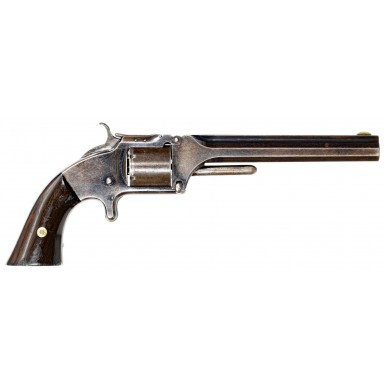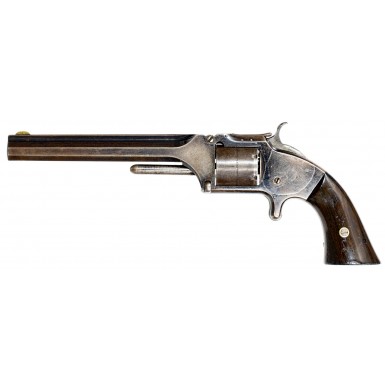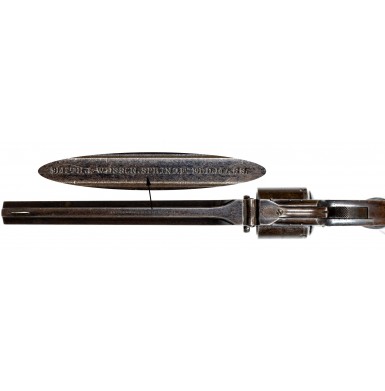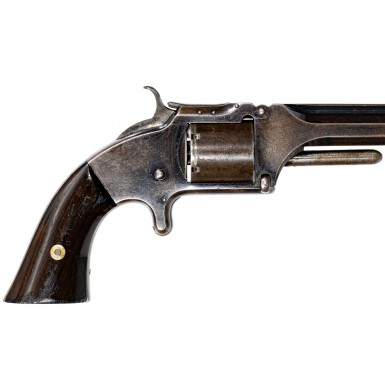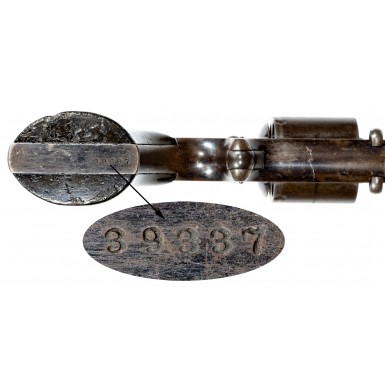1865 Production Smith & Wesson No 2 Old Army Revolver
- Product Code: FHG-2255-SOLD
- Availability: Out Of Stock
-
$1.00
This is a FINE example of one of the most popular metallic cartridge revolvers of the American Civil War period. The Smith & Wesson No 2 Old Army revolver was a six shot, .32 caliber single action revolver that fired a .32 caliber rimfire cartridge. The revolver was introduced in 1861 and remained in production until 1874. During that time some 77,155 of the revolvers were manufactured. Those pistols under serial number 35,731 were produced prior to May 1, 1865 and are considered revolvers that may have seen Civil War use.
The pistol used Smith & Wesson’s “tip up” action design that they introduced with the .22 caliber No 1 Revolver. To load or unload the pistol the release at the bottom of the frame was pushed, allowing the barrel to be tipped up and the cylinder removed. Pushing the chambers over the fixed ejector rod under the barrel removed the empty cartridges, allowing fresh cartridges to be dropped into the chambers. These guns were very popular personal side arms for soldiers and officers on both sides during the during the Civil War, as they were smaller and lighter than similar percussion revolvers and were less likely to get out of order or misfire in wet conditions. Smith & Wesson No 2 pistols were known to be owned and used by such diverse and historic figures such as Brevet General George Armstrong Custer and the infamous lawman “Wild Bill” Hickok. Period images regularly show soldiers with an “Old Army” revolver stuck in their belt. From the standpoint of size, weight and cartridge power, the Smith & Wesson No 2 was probably one of the most practical pistols for company grade officers to carry in the field. It was lighter and easier to deal with than a Colt Navy or Colt Army percussion revolver and was more powerful than the popular .22 rimfire pocket pistols of the era.
This Smith & Wesson No 2 is serial number 39337, which places its production in months immediately after the conclusion of the American Civil War. The serial numbers for Smith & Wesson No 2 revolvers produced in 1865 run from 29,359 through 48,475, with a production of 19,116 that year. The serial number is very clearly stamped in the bottom of the grip frame and is also stamped inside of the right grip panel. The gun is mechanically excellent with a crisp action and a very tight lock up. The gun times and indexes exactly as it should. Typically, these “tip up” revolvers are found with excessive play in the hinge between the barrel and frame and they tend to wiggle. This one is nice and tight. The top of the barrel rib is clearly marked in a single line with the typical Smith & Wesson information:
Smith & Wesson Springfield. MASS.
The cylinder is clearly marked around its center:
PATENTED APRIL 3, 1855. JULY 5, 1859 & DEC. 18, 1860
The April 3, 1855 date referred to the Rollin White patent for the bored through cylinder. The July 5th date referred to Smith & Wesson’s patent for an improvement to the frame design of their earlier No 1 revolvers, which allowed larger caliber rimfire ammunition to be used more reliably, and the December 18th patent described in detail the revolver that would become known as the “No. 2”.
This gun has the highly desirable 6” ribbed barrel, considered the favorite barrel length for those soldiers who carried an “Old Army” in the field. The pistols produced with 5” barrels are the most common, and the 6” guns are the second most often encountered. The gun has the matching assembly number 517 stamped on the left grip frame under the grip panel, on the face of the cylinder and on face of the barrel frame below the forcing cone. As noted, the gun is in about FINE condition. It retains about 30%+ of its original blued finish overall, most of which is in protected areas on the frame as well as similarly protected areas on the barrel. The revolver shows finish fading, thinning and wear from carry and use, as would be expected. The most obvious loss is high edge wear along the octagonal barrel and fading and wear along the sides of the barrel, the backstrap and grip frame. The blue on the cylinder has faded and worn leaving a very pleasing plum brown patina that blends well with the finish remaining on the balance of the pistol. The backstrap and gripstrap have a mostly smooth brownish patina with flecks of minor surface oxidation and age discoloration. The areas of the gun where the blue had faded and worn has developed a mostly plum brown patina similar to that found on the gripstrap and backstrap. The metal is almost entirely smooth, with some scattered light pinpricking present, mostly at the muzzle, around the face and sides of the cylinder, on the sides of the frame forward of the cylinder and inside the frame and on the rear face of the barrel assembly. There are also some scattered areas of light surface oxidation and roughness present on the cylinder. The bore of the pistol is in about FINE condition. The bore is mostly bright with some small darker patches and some lightly oxidized discoloration. The rifling remains very crisp with some very lightly scattered pitting here and there along its entire length. The gun retains sharp edges along the octagonal barrel, and the original German silver sight blade remains in place at the end of the barrel and shows moderate discoloration from verdigris. The rosewood grips are original to the gun and are in NEAR FINE condition as well. They retain about 70%+ of their original varnish. The grips are free of any breaks, cracks or repairs. The grips do show some minor bumps, dings and handling, marks, and a small chip out of the lower edge of the right grip, but the grips still remain fairly crisp overall. They retain nice edges, and they are very attractive, matching the revolver’s condition very well.
Overall this is a very nice example of one of the most popular Civil War era side arms. The gun is 100% complete, correct and original, and it functions perfectly. This gun represented the first truly successful, mass-produced American cartridge pistol that was chambered in a reliable caliber that could actually be called an “effective” combat or self-defense cartridge. All previously successful metallic American cartridge revolvers had been chambered in the anemic .22 RF short or in some strange patent cartridge that was expensive, unreliable and difficult to obtain. The Smith & Wesson No 2 was a breakthrough revolver in these respects and is one that no Civil War handgun collection is complete without. This is a very nice example that will be a wonderful addition to your collection of Civil War era secondary martial revolvers.
SOLD
Tags: 1865, Production, Smith, Wesson, No, 2, Old, Army, Revolver


